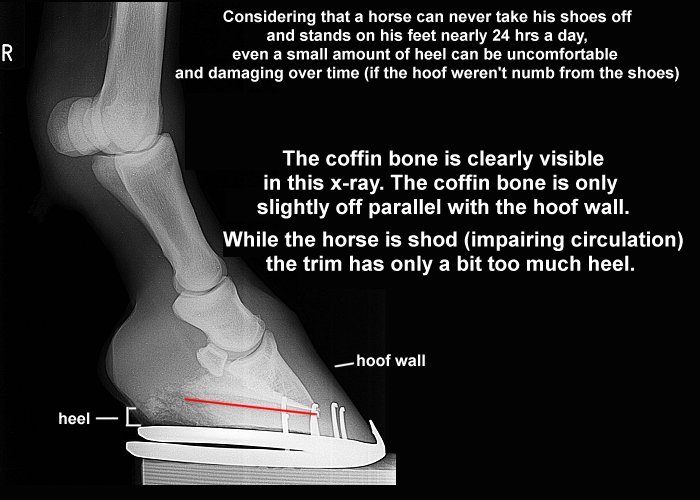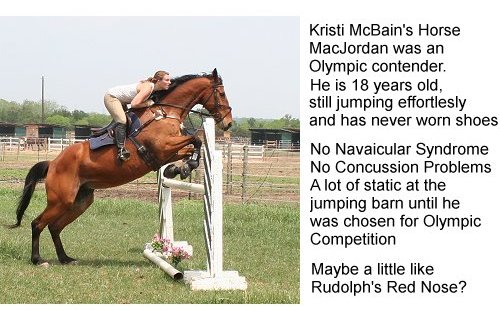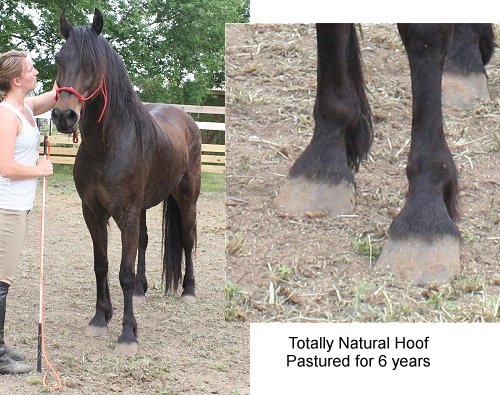 A “barefoot” horse is a horse that has no shoes nailed to the bottom of its hoof.
A “barefoot” horse is a horse that has no shoes nailed to the bottom of its hoof.
There is considerable merit being given to the theory that horses should not wear shoes. Given that the frog is meant to act as a shock absorber and the necessity for the hoof itself to expand and contract in order to stay healthy and pump blood from the lower extremities, shoes may be very ill advised.
While wild mustangs have natural feet, worn down by exercise and terrain, stabled horses exhibit long toes, high heels, and generally dysfunctional hoof health.
Reasoning that stabled and sport horses often encounter abnormal levels of exercise and activity that may put more stress and strain on their hoofs than wild horses endure, many people still shoe their horses. However, this reasoning is being debunked.
See Frog
If you examine the sole of a shod horse, you can often see a shrunken, dead-looking and useless frog. Additionally, many sport horses are unable to compete for the years a horse should be useful, and, indeed, many of them are lame within just a short time. As additional evidence that shoes may be detrimental, navicular syndrome is completely absent from wild horses.

For this reason, more and more athletes, trainers, and leisure riders are learning how to keep a barefoot horse.
Shoeless is not the end of it. It requires re-shaping the hoof capsule to get the bottom of the coffin bone ground-parallel as it should be.
A natural hoof trim is a ‘physiologically correct’ trim, which respects the internal structures of the hoof and provides proper hoof mechanism and function. It aims to not only maximize circulation to the inner structures of the hoof, but also – like muscular movement – to assist the heart in pumping blood right from the hoof up.
The correct trimming of the hoof includes
1. shortening the hoof wall
2. scooping out the sole around the frog in a concave manner (depending on how much unhealthy pathology there is already going on in the hoof, this can be minor or major)
3. rounding the toes so that the hoof itself is round in the front and the “breakover” (the moment when the foot unloads weight and tips forward as it begins to lift off the ground) is proper to prevent tripping, chipping and improper gait
4. lowering the heels (level with base of frog and base of heel bulbs) so that the correct pastern and leg position do not put pressure on the coffin and navicular areas.
5. Strong, curved bars (non-weight bearing when horse is stationary) (see Hoof)


Generally speaking, the front of the coffin bone should be parallel to the hoof wall and the lower surface of the coffin bone is roughly parallel to the ground surface. Anything that disturbs this position, forcing the toe of the coffin bone lower and the heel of the bone higher, puts tremendous stress on the hoof sole and causes pain and lameness.
Laminitis (from metabolic disorders or other mechanical stressing) is a condition where the tendons inside the hoof swell or even tear, allowing the coffin bone to rotate inside the hoof capsule. (see Founder)
Horses whose heels are too high rotate the weight-bearing to the front of the coffin bone (much like women who wear high heels) and can change the relationship of the angle of coffin bone to the ground. As that angle changes, it can also change the navicular area – particularly in decreasing blood flow to and from the navicular bone. As impairment continues, it can thicken and permanently reduce the blood flow.


Any condition that promotes concussion such as upright pasterns or long toes can contribute to the constant stress of the navicular bone, leading to heel pain and hoof / heel contraction.
When a horse is shod, a metal shoe is nailed to the hoof. It renders the hoof totally inflexible and changes the physiology of the hoof, leading to poor circulation and numbness.
Because the nerves in the hoof area are damaged, the horse cannot feel the pain of his ever-degenerating feet, and he is considered sound by virtue of the fact that he is “pain free” and functions. His “soundness” is, of course, questionable, and a potentially debilitating hoof problem can go unnoticed for a very long time.
When shoes are removed from a horse that has worn them for a long period of time, the horse’s feet may be very sensitive. It may take successive trimming, gradual lowering of the heels, gradual expanding of the heels, gradual scooping, and gradual recovery of the frog before a newly barefoot horse is comfortable. Half boots can be useful for horses that are being rehabilitated by more radical trimming.
Also look for deep Thrush in horses that have been shod for long periods of time, as poor circulation caused by the hoof’s lack of flexibility can encourage Thrush in deep bulb grooves of narrow heels.
There is considerable research that indicates that removing horseshoes and properly trimming a horse’s feet can reduce or in some cases eliminate the pain of laminitis and navicular syndrome, which is an inflammation or degeneration of the navicular bone and its surrounding tissues that leads to disabling lameness. They are two of the most common reasons a horse is prematurely retired or even euthanized.

With proper trimming and less standing (pastured horses walk an average of 10 miles a day), many potential and current navicular horses can be saved and foundered horses rehabilitated.

(see Pasterns)
We certainly don’t know everything. Please share your expertise and experiences. Comment on what is already written or Suggest a Category and Educate us about it. Grow Horse-Pros.com©
